How to Smoke a Brisket: The Ultimate Guide
Are you smoking brisket for the first time? Congrats! There’s nothing better. In this post, we will share our best tips on how to smoke a brisket – from picking out the perfect cut of meat to cutting it correctly, we’ve got you covered!
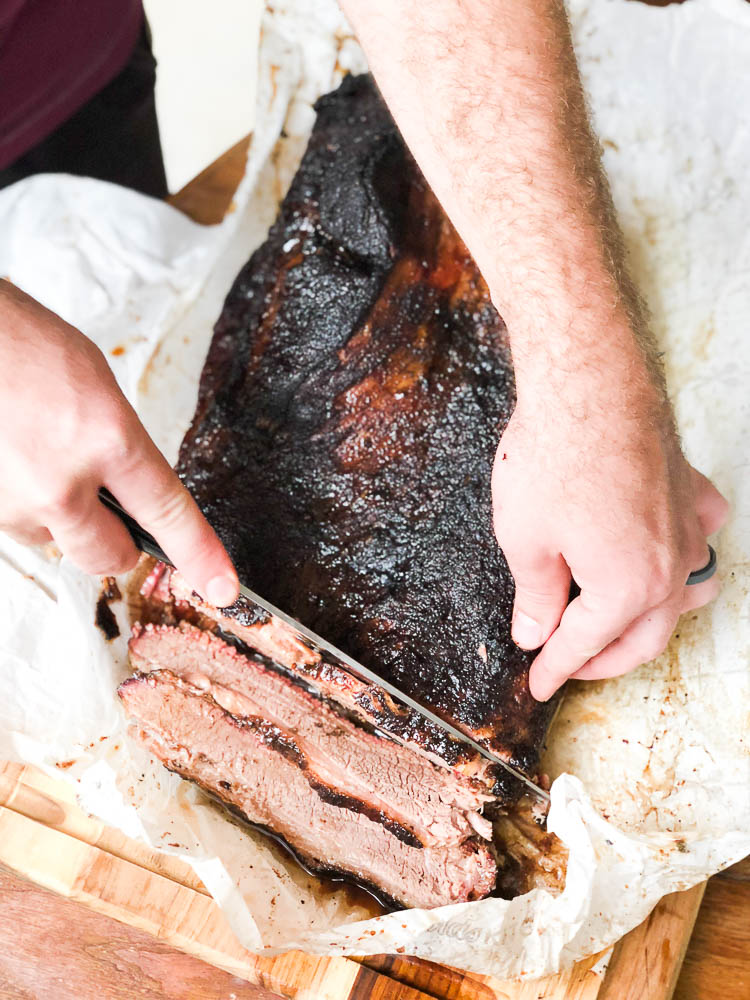
Smoking Brisket
Earlier this summer, my little brother returned from his LDS mission to Portugal. We had LOTS of family in town, so I offered to host a BBQ one night at our house.
Because we had recently gotten a Traeger Timberline 850, we decided that we wanted to go all out and smoke a brisket.
I know that people always say to never try new recipes on guests…but I always do that, and it usually works out for the best.
As I researched how to cook a brisket, I discovered one thing:
There are LOTS of opinions.
I looked in various smoking Facebook groups, and I swear, every answer was different – from cooking time, to how to season it, to whether or not a brine is necessary…I’ll admit, I was SUPER overwhelmed.
Thankfully, I had two fellow smokers around a lot that week (my brother, Daniel, who helps run My Latina Table, and my brother-in-law, AJ, who runs an Instagram account dedicated just to smoking – Slowpoke_smokin), so after talking with them, looking in the Traeger app, and doing lots of online research, I came up with a pretty solid plan.
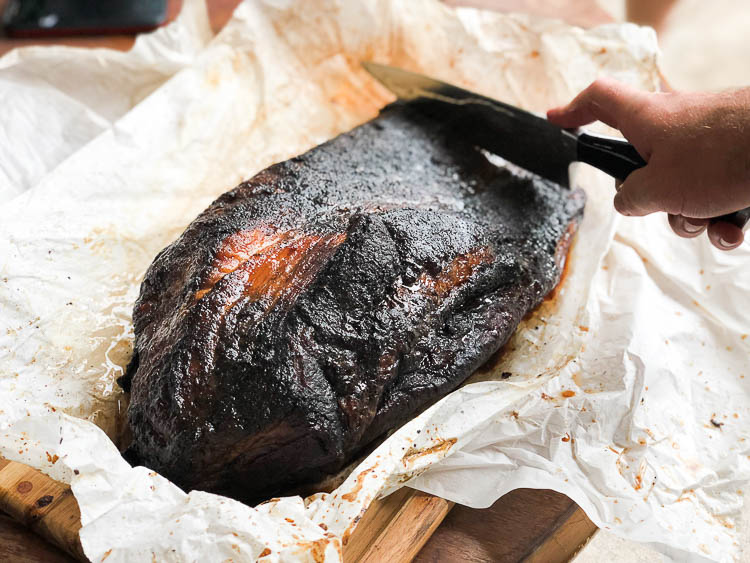
How to Smoke a Brisket
What smoker?
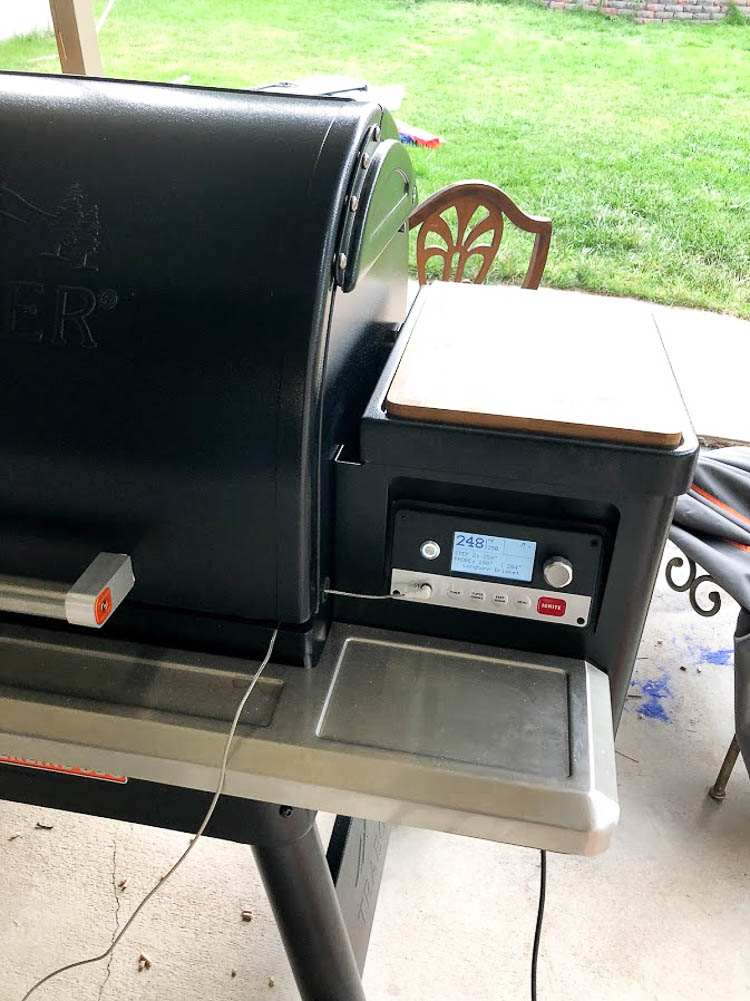
So first off, I thought I’d share what smoker I used. We have the Traeger Timberline 850, which is a workhouse. It’s really big, has some amazing features, and it cooked our brisket beautifully. We did have some issues in the beginning, but I think that was more user error than anything. I LOVED the WiFIRE technology that allowed me to control the smoker remotely. Because I was worried about it turning off again, I was super paranoid…but I was able to leave the house and still monitor things.
With that said, the Timberline series is pretty expensive, and it may not be in your budget (we’d never suggest getting something you can’t afford!). Fortunately, Traeger offers a HUGE variety of smokers that can fit most budgets, so make sure you check out their selection here. I will be doing a more in-depth comparison soon, but you can browse their site pretty easily! From everything I’ve read, Tragers are definitely the way to go when it comes to smoking.
What is brisket?
Brisket is one of the most delicious meats! It’s a bit pricier, but it’s SO good.
It is cut from the breast or lower chest of a vow or veal. It is actually not super high in fat, which makes it great for those of us who are following a macro-based diet!
Where to buy brisket?
Most grocery stores sell brisket – though the size and quality does vary. After reading a lot of different posts and forums, it seems as if most people buy theirs from Costco.
We bought ours at Sam’s Club (because we were right by there), and the whole brisket price was about $3.00 a pound, which we thought was great. If we had just gotten the flat, the price went up significantly, which also played a part in why we decided to go with the whole.
We saw some cuts at King Soopers (a Kroger store) and Walmart as well, but they were in smaller sizes than we wanted. So I would definitely go to a place like Costco or Sam’s Club or even a local butcher shop. We went a few days before to Sam’s Club, and they didn’t have any in the size that we wanted. However, they get a shipment every morning, so we just requested a certain size, and they had it ready for us the next day at 10 AM.
What cut of brisket?
This really depends on the recipe you are following, how much trimming you want to do, and the size of the brisket…and who you talk to 🙂
There are two main cuts of brisket you can buy – either whole (or the packer cut), or cut into the flat and the point. I’ve read that you should really either do the whole or the flat. You can get some great cook on a point, but it can be more difficult to cook right (especially for a beginner).
A lot of people will say to go with the flat when you are first cooking, but we used a whole brisket, and it turned out great.
With a packer cut, it generally is the heaviest cut of brisket. It’s untrimmed, and it usually has a strip of fat through it and on top (which is the fat cap). They can take longer to cook, but the results are absolutely worth it.
The flat cut typically has less fat, and it’s the most expensive of any cut.
The point cut is sliced with the deckle – or fat – so it can be more flavorful and have more texture.
However, you can still make an awesome brisket using the flat or point. I would recommend finding a recipe that is specifically for these cuts of brisket.
You should also look for the following when selecting your cut of meat:
- White fat
- Deep, rich color that is red
- Weight
- Good marbeling – there is a debate on whether or not this is necessary because the marbeling will mostly be on the inside (which you can’t really tell from the outside when you buy it)
How many pounds per person?
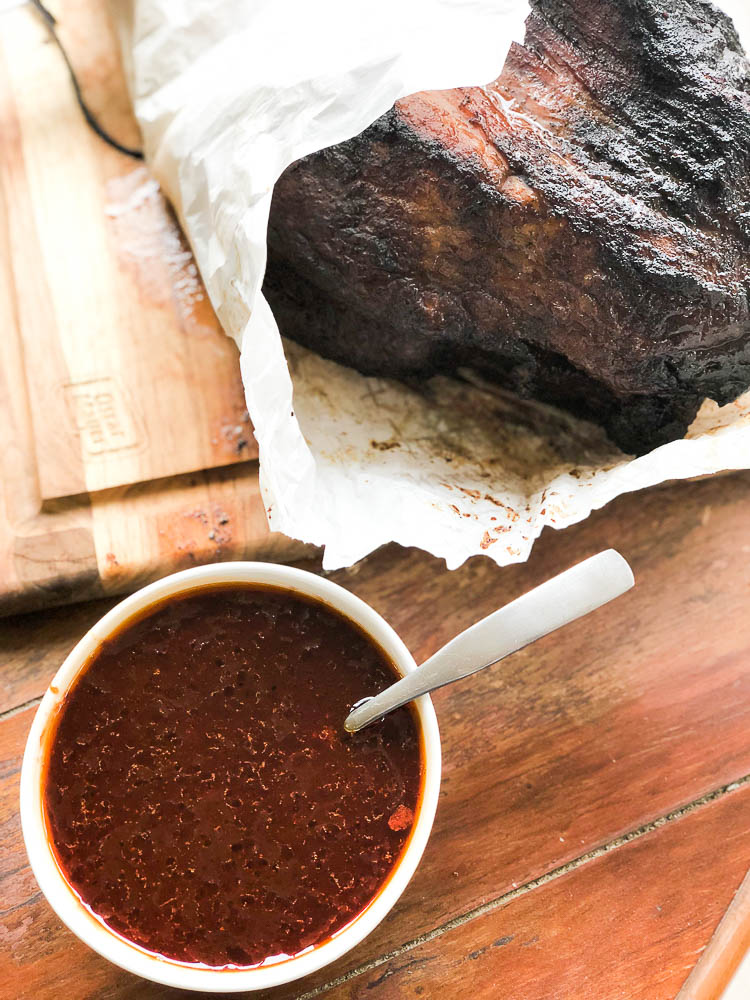
In general, it is recommended to have about 1/2 pound of meat per adult (we had a lot of kids, so we factored in about 1/4 pound per child). However, If you have lots of sides to go with it, you could probably get away with a less.
Most cuts of brisket will be at least 10 pounds, but keep in mind that it will lose a good amount of its weight while cooking (some estimate about 30%!). We started with over 15 pounds, and I would estimate when all was said and done, it was down to 12 pounds. We had about 15 adults and 17 children, and we had about 1/4 of that brisket left afterward.
You should also take into account how you want to serve it (sliced or shredded) and what others sides you will have!
Prep Brisket
A good brisket starts well before you get it on the smoker.
If you buy a whole brisket, you will need to trim it. This is a great post all about how to trim a brisket. Instead of reiterating her steps, I just recommend clicking over there to read them. It’s a great post!
You will want to trim your fat to about 1/4″ thick. I think that’s partially why we didn’t have as nice of a smoke ring as some briskets get, because we had a *little* bit too much fat. It still tasted great, but I wish we’d made sure to cut more of it off.
Before you put it on the smoker, you will need to decide if you want to marinade or season it, which I’ll take about next!
Seasonings and Marinade
This is one of the topics I found A LOT of opinions on while doing research for cooking my brisket. Some people said you don’t need ANY seasonings, and by using seasonings, you ruin the integrity of the beef (which I found a tad overboard). Others used lots of seasonings, liquids (such as beef broth or apple cider), and mop sauces. And honestly, I think a lot of it comes down to preference.
I do think having a nice rub can enhance the flavor. A marinade can really help with tenderizing the meat and help to break down some of the fibers. Anything with some acidic aspect to it is a great option.
Mop sauces can be great, though I wouldn’t recommend starting to apply until maybe the last four hours of cooking. Keep in mind that your smoker will lose some of its temperatures every time you open it, so it’s generally best to keep it closed as much as you can.
Brisket Rubs
I do think that a brisket needs a good rub – for some, that will just be salt and pepper. Others may add in some onion powder, garlic powder, or even coffee grounds. We chose to use the Traeger Blackened Saskatchewan Rub, which was delicious. Traeger has some other rubs, such as the Beef Rub or the Traeger Rub. If you like the taste of coffee (which we don’t), the Coffee Rub would be a good option, too.
You can easily make your own though – most brisket rubs use common ingredients that most people will have either way. I found this brisket dry rub that sounded delicious!
How Long Does it Take to Smoke a Brisket
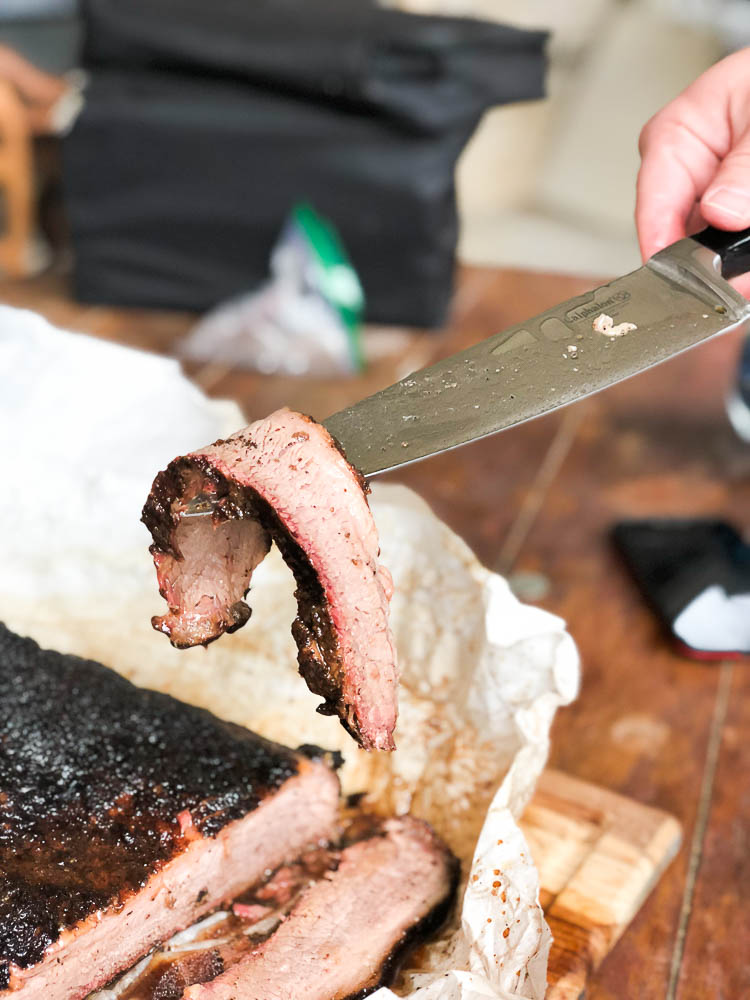
One thing I learned from all my research is that you shouldn’t cook by time, but by temperature. Which, for people who like to rely on the clock (aka, me) can be kind of aggravating. However, as we cooked our first brisket, we definitely found this to be very accurate.
There are a lot of factors that go into how long it will take for a brisket to cook – size, fat, cut, and whether or not you wrap it.
What I’ve read generally suggests about an hour per pound of beef (though you’ll see recommendations from 30 minutes to 1.5 hours). So my best advice when it comes to when to start your brisket is to start early – there are several things you can do if it gets done early, but there’s not a lot you can do if the brisket isn’t done by the time your guests start to arrive.
We started our brisket at 2 AM – however, somewhere during the night, the pellets got jammed, and the temperature of the grill dropped, so it turned off. I believe this was around 6 AM (it was still warm when I discovered it at 7 AM, and the temp was around 104). We took it off the smoker at around 4:30, when it had reached the temperature of 197. I wish we’d been able to let it cook just a *little* bit longer, but it is what it is and still tasted great. We started with a 15 pounder (probably trimmed down to 14 pounds), so it was probably cooking for about 14 hours total – so I would definitely have at least an hour per pound factored into your cooking time – had our smoker not shut down, it probably would have been closer to 12 hours.
Stall Time
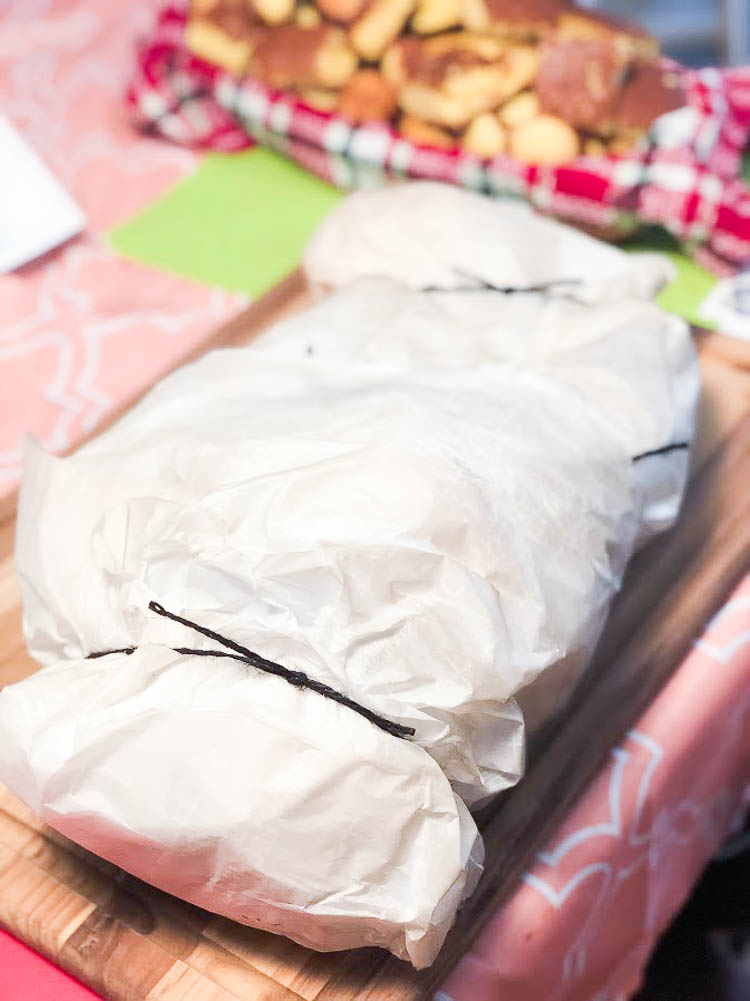
So you’ve been cooking your brisket for several hours, and it’s gotten to the 140-160 internal temperature…and the temperature stops going up.
This can be alarming to anyone, especially as the hours for when you are supposed to eat comes closer! However, rest assured that stalling while cooking can be normal.
I read A LOT about stall time while I was waiting for our brisket to cook. I was super worried about it happening for hours, especially since I was already behind schedule with mine. I found this article on “Understanding and Beating the BBQ Stall“, and I found it SUPER helpful. It busted a lot of myths and gave some good reasoning behind why meat starts to stall. I recommend reading the whole article, but here is a quote from the article that sums up their conclusion:
“Since there was a deep, glistening pool of melted fat in the smoker, the rendering fat hypothesis is busted. The barbecue stall is a simple consequence of evaporative cooling by the meat’s own moisture slowly released over hours from within it’s pores and cells. As the temperature of cold meat rises, the evaporation rate increases until the cooling effect balances the heat input. Then it stalls, until the last drop of available moisture is gone.”
Stall time can vary! As I was reading in some Facebook groups, some people said they never had one, while others said it lasted for HOURS. However, as soon as it ended, the temperature rose very quickly.
When we made our brisket, we really didn’t experience it, and I believe it’s because we wrapped it and added some liquid. This was the suggestion from one of the recipes we followed for our brisket in the Traeger app, and we really saw no stall. Some people don’t like wrapping it, but it definitely saved us. I’ve also heard this called the “Texas Crutch”.
A lot of people recommend using butcher paper, but we couldn’t find any in a pinch, so we ended up just using parchment paper and twine. Some of the Traeger recipes recommended tin foil.
This is a great article that talks about wrapping with tin foil, butcher paper, and having a bare naked brisket, which can help you decide what method is best for you. I’ve been told the bare naked brisket is the way to go, but you have to have PLENTY of time in order to do it!
What temperature should you smoke brisket at?
This is another one of those things you’ll find a variety of opinions on – in general, low and slow is almost always going to make for the best brisket, but it can be a long haul.
Some recipes I saw started at like 195 for the first four hours, and then it went up to 225. Most of the recipes I saw, however, seemed to have it stay at 225 for the majority of the time, which is what we ended up doing. Toward the end I kicked the temp up to 250 for a bit because I was getting impatient, but I don’t think I really needed to. In general, if you are sitting around 225, that will be great.
Many smokers will have a temperature swing, so you will likely see it go up 10-15 degrees or down 10-15 degrees during the process. Don’t let this concern you!
What pellets should you use?
When smoking anything, you need to make sure you have top notch pellets – and ones that are optimal for what you are cooking.
I might be biased, but I do think that Traeger has really high-quality pellets. If you have a Traeger, I would strongly recommend using their pellets as they are designed specifically to be used with Trager smokers. If you don’t have a Traeger, it would be wise to look up what your brand of smoker recommends. The right pellets are worth investing in.
Traeger has a lot of different blends, and it’s pretty easy to pick which one you want to use based on the description. For our brisket, we used the signature blend hardwood pellets. They were perfect! It can really depend on the flavor you are going for. I think the Mesquite could be good, as well. Traeger also has a Traeger Beef pellet collection, which I can only imagine how perfect it would be for brisket!
You want to make sure you have enough pellets in your pellet hopper!
Cutting your Brisket
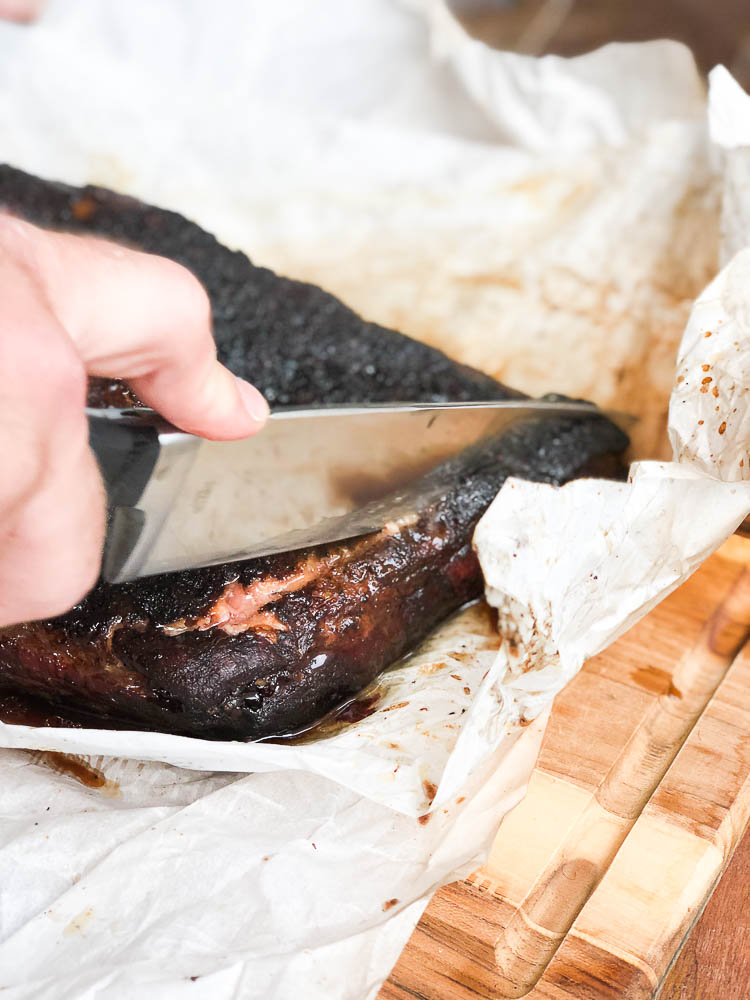
Yes, cutting your brisket correctly is crucial!
You want to let it rest for at least 20 minutes (though longer is preferred) before you start cutting it. Some people will even wait up to 24 hours before they slice into their brisket. When we cooked ours, it had been about an hour.
Next, make sure you have a long, serrated knife (around 8-10 inches). This will give you the smoothest cut. It should cut like butter!
First off, you need to figure out which way the grain is going. This is the way the muscle fibers are going.
Then you can start slicing. You want to cut against the grain rather than parallel with.
That’s the simplest approach – but again, I’m going to direct you to Hey Grill Hey for more detailed instructions and pictures on how to slice a brisket.
Timeline
Prep time – about 15 minutes to trim the excess fat to about 1/4″.
Marinade/Pre-Seasoned – if you are marinating your brisket, you want it to have around 12 hours in the fridge. If you are just seasoning, you will need at least one hour of it in the fridge with the rub on it before you start cooking.
Cook time – As I mentioned above, this will vary! Ideally, the internal temperature will be between 197 and 203 when you take it off from the smoker. I would say about 1 hour per pound of brisket.
Rest Time – You want to have around an hour before you cut and serve the brisket for it to rest (20 minutes minimum). If your brisket has more than hour before you want to eat it, you can preserve the tempearture by wrapping it in old towels and placing it in a cooler. This will keep it at the right temperature for about three hours.
Cutting – This should just take a few minutes!
Brisket Recipes
There are a lot of great brisket recipes out there – some just have some simple seasoning, while others have delicious mop sauces applied while cooking.
For the Brisket we made, we loosely followed THIS recipe from Traeger. We really just seasoned it with Traeger Blackened Saskatchewan Rub – and when we wrapped it once it reached about 160 degrees, we added some beef broth.
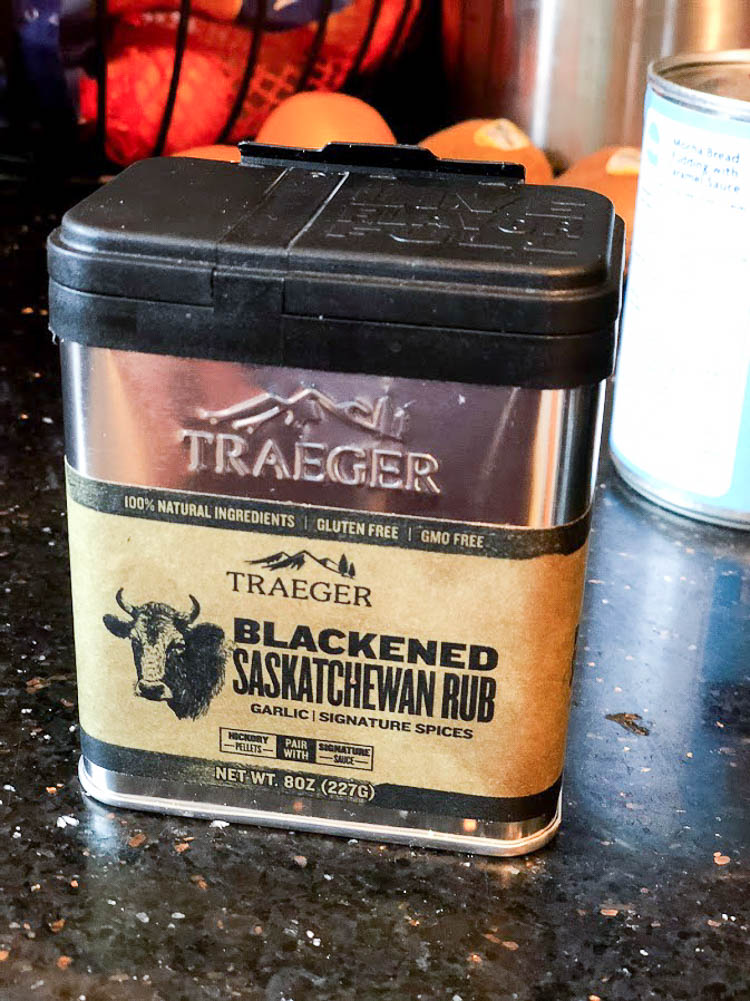
It turned out delicious, and we had a BBQ sauce on the side that we made with Traeger Sweet and Heat and the drippings (we combined them together in a saucepan on the stove). We LOVED the sweet and heat, but here are a few other signature sauces from them that I think would have been delicious:
- Traeger Q sauce (We LOVE the Q Sauce!)
- Signature BBQ Sauce
- Texas Spicy BBQ Sauce
Of course, you can use your favorite sauce from the store (or a homemade BBQ sauce) as well!
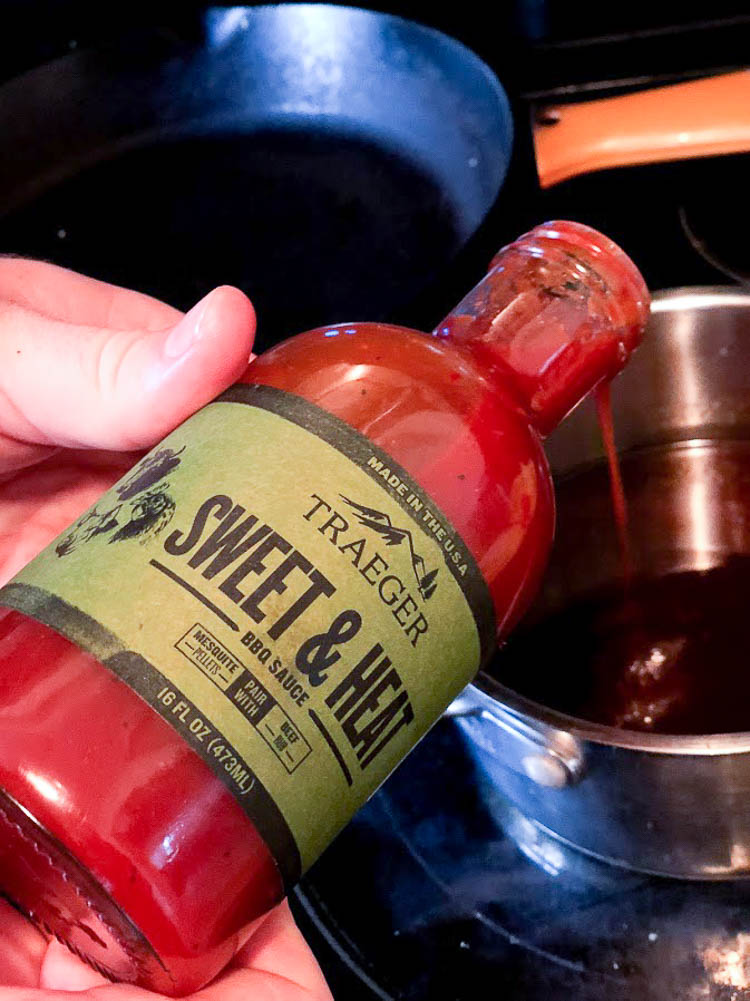
Here are some other brisket recipes you try:
Smoked Brisket with Homemade Mop Sauce
What to Serve with Brisket
While brisket will certainly be the star of any meal, there are lots of great sides to complement it. HEre are a few ideas:
- Rolls (for serving on as sandwiches or just on the side)
- Cornbread
- Macaroni Salad
- Pasta Salad (our zesty pasta salad is a good option)
- Macaroni and Cheese – definitely keep in mind our slow cooker mac and cheese
- Corn on the cob
- Potato Salad
How to Freeze Brisket
As delicious as brisket is fresh after you cut it, it sometimes can be even better later! We had about 3 pounds left of our brisket after our party, and we didn’t think we’d be able to eat it all before it went bad. So we decided to freeze it. I thawed it about a month later, and it tasted delicious!
Here are a few tips for freezing it for optimal freshness:
- Cool in its cooking liquid – you may want to wait until then next day to freeze it
- Layer slices in a single layer – flash freeze them in the freezer on a cookie sheet for about three hours. Then place them in your storage bags
- Place in a freezer bag or even use a vacuum sealer
- Label and freeze!
- Defrost as you normally would
How to Use Leftover Brisket
There are so many delicious ways to use brisket! Here are a few ideas:
- Sandwiches
- Tacos
- Nachos
- Hot Dogs
- Casseroles
I found these recipes on the Traeger that require leftover brisket:
- Traeger Frito Pie
- Brisket Nachos
- Brisket Tacos
- Brisket Breakfast Tacos
- Brisket Pizza
- BBQ Brisket Hot Dogs
- Smoked Chili Brisket Nachos
Other Posts You May Enjoy:
- How to Make Pizza on the Grill
- BBQ Dutch Oven Chicken and Potatoes Recipe
- The Ultimate Instant Pot Guide: Instant Pot Tips, Hacks, and Recipes
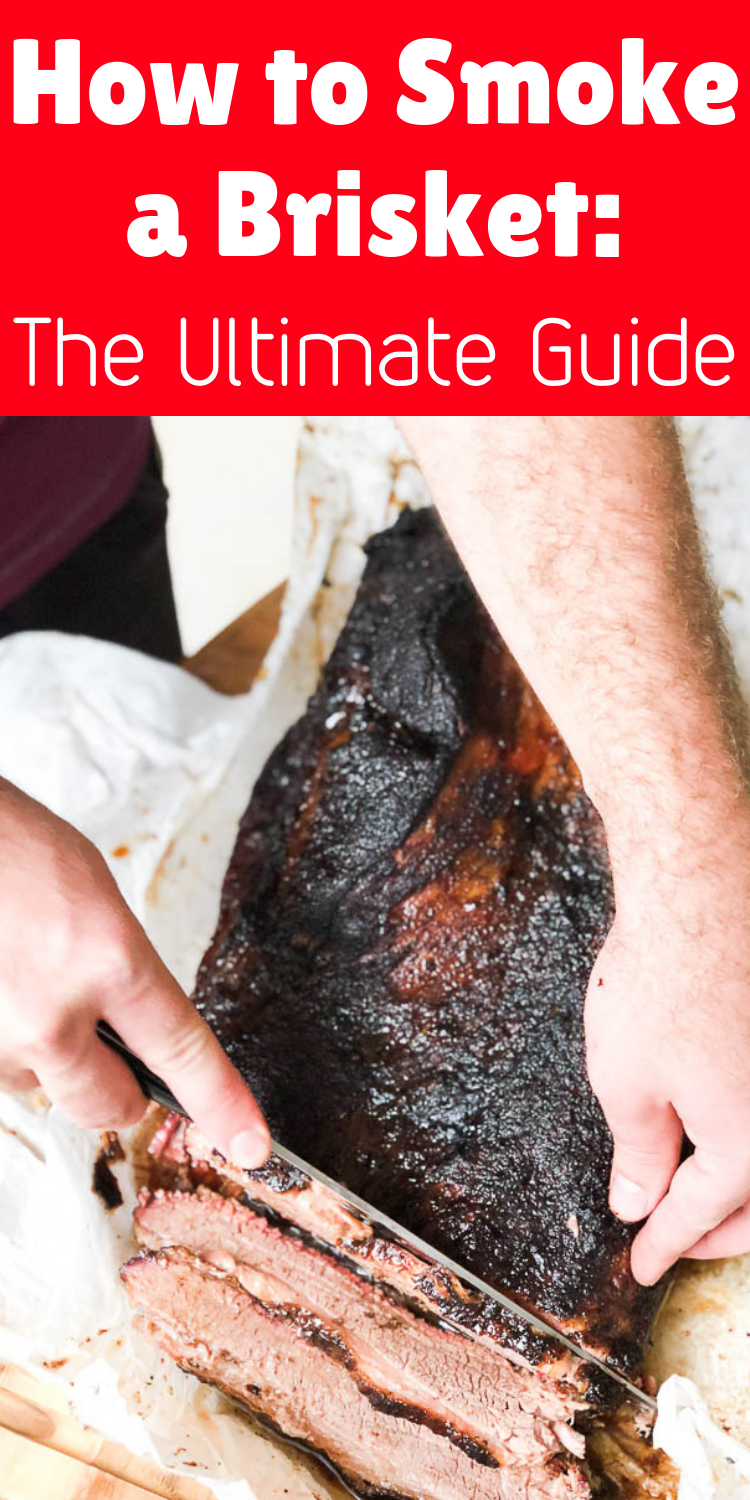

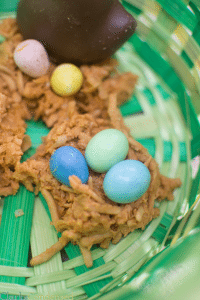
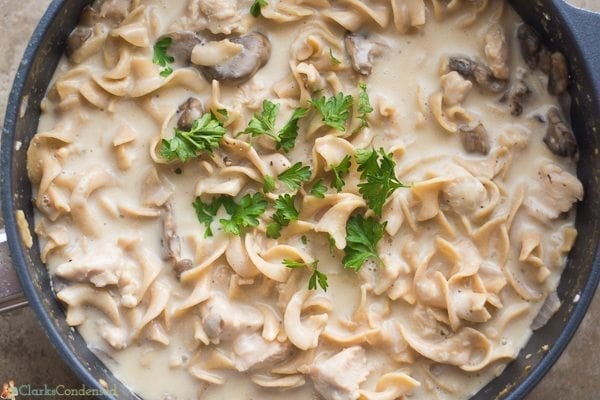

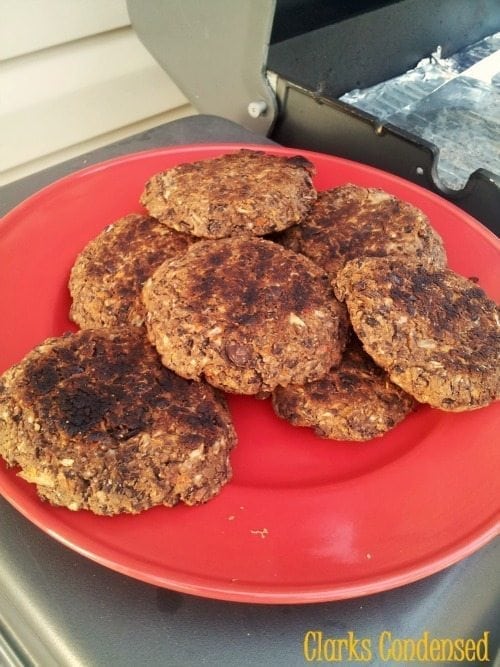

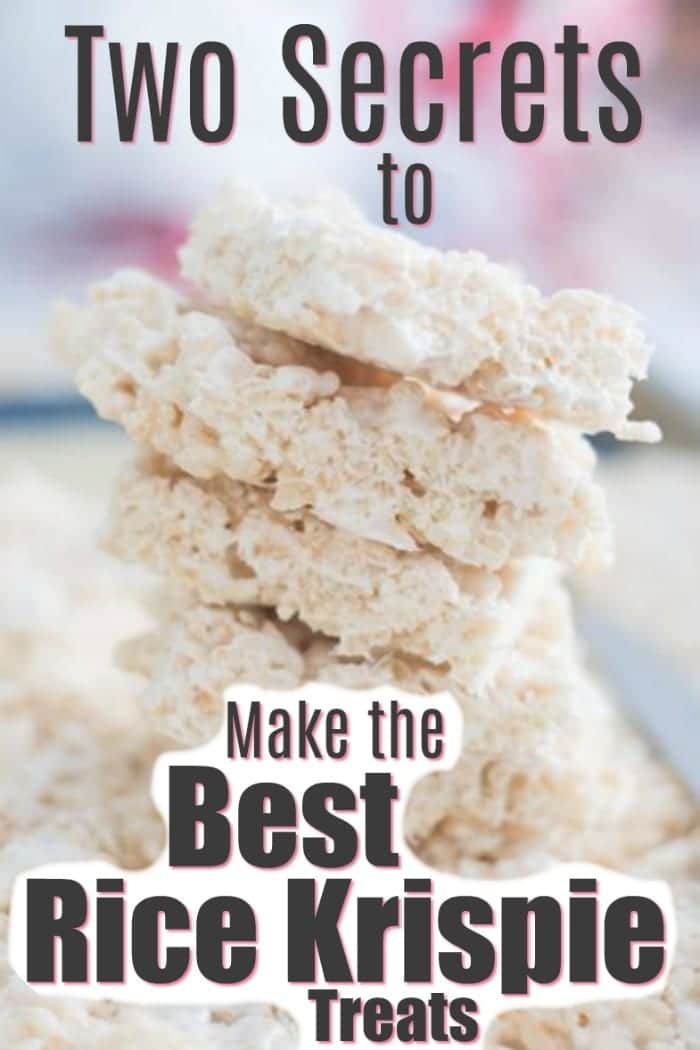
you explained the diff types of brisket GREAT but lets use charcoal,wood for smoke home made sauce ,dry rub instead of elect smoker set and forget get down and do some real cooking Thank You Harold
To each their own! This worked well for us. I’m sure your brisket turns out great <3
If I learned anything from this post, it’s that brisket is a lot of work, but yours looks amazing!!! My husband’s brother has a Traeger and we smoked a Papa Murphy’s pizza on it, and that was super good! I’m definitely saving this post for if we ever get a smoker!
ahahah! This is so true! It is a lot of work. But yes – I’ve heard amazing things about Papa Murphy’s on the Traeger!